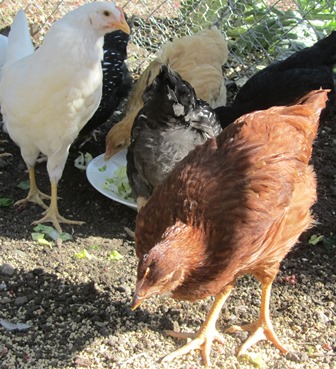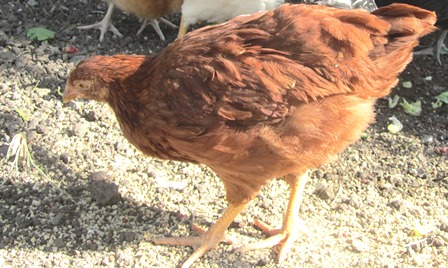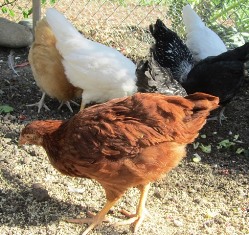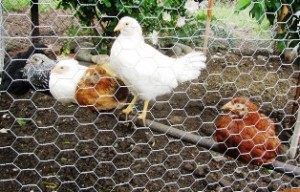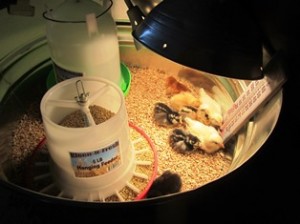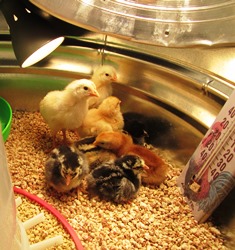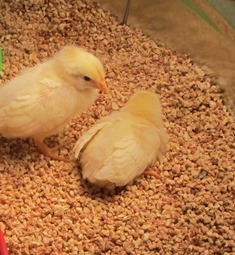Buffo’s Gone Broody
My Buff Orpington hen won’t leave the nest. I’ve taken to putting out a bowl of crumbles and a canister of water so she’ll have nourishment while she sits on a a pile of eggs.
I’m beginning to think that with her this broody period is going to happen about every six months–at least that’s been the case so far.
Ruby the Rhode Island Red, the Wyandotte sisters, the Black Sex Link, and my two white leghorns are being de-laned into the two other boxes. And I have to practically crawl into the chicken house to reach the last nest box to retrieve their eggs.
Our town doesn’t permit us to keep roosters. Ergo, those eggs that Buffo is trying to hatch will have to be tossed at the end of her broody period. They’re not fertile and will never hatch. But I haven’t the heart to tell her.
* * *
If you enjoy reading about farmette life, check out my cozy mystery novel series from Kensington Publishing, New York. The books feature a farmette milieu, farm sayings, tips, and facts as well as delicious recipes to try. The books are available from online sources such as Amazon, Barnes & Noble, Walmart and others as well as traditional bookstores everywhere.
Consider This Before You Get Backyard Chickens
My bedroom window faces the back of our property where the chicken coop sits. Every morning, I’m awakened by repeated grauwkkkk sounds made by the Silver Laced Wyandottes and the Rhode Island Red hens, the noisiest ones of all my chickens.
I wish I’d read up more on the breeds before making my selections at the feed store. I love keeping chickens and the eggs are fabulous. That said, there are some of the areas I wish I’d known more about. I might have chosen different breeds.
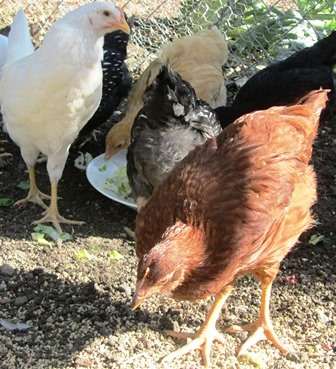
Rhode Island Red hen seems to be at the top of the pecking order in this small flock of backyard chickens
1. Noisemakers–some breeds are noisier than others. I seldom hear the occasional cluck from my White Leghorns, but the Wyandottes never seem to shut up. Get a bunch of hens together and conversing, and you’ll soon see what I mean.
2. Snacking–chickens love snacks but give them judiciously. If they consume too many treats like blueberries, fresh corn from the cob, and bits of bread or rice, the quality of their eggs may suffer. But as soon as you give them treats, they become your best friends and will follow you around.
3. Pecking–chickens quickly establish a pecking order; they will also peck you . . . some harder and more aggressively than others. My Black Sex Link hen just seems kind of mean and pecks with impatience. But the Rhode Island Red will give an almost loving peck that’s not hard and doesn’t hurt.
4. Broodiness–when a hen goes broody (like my Wyandotte and Buff Orpington hens), her hormones have told her she needs to sit on a clutch of eggs until they hatch (about three weeks). But if you do not have a rooster to have fertilized those eggs, the hen will sit on them anyway, tying up a nesting box and hoarding eggs that will have to be tossed out when she finally figures out that she’s engaged in a futile pursuit of baby chicks. Some breeds tend to broodiness more than others.
5. Water and Food–chickens need water, love crumble, and can benefit from a serving of cracked grains and dried worms. To ensure their egg shells are sufficiently rigid, they may also need additional oyster shell calcium. And like all living beings they need fresh water. If they go without water, they can stop laying for weeks. I’ve figured out the cracked grains must be so tasty they are like cotton candy and after them, the hens don’t want their good food.
6. Diminishing Returns–hens begin laying when they are about five months old. After the first year, egg production will fall off about 20 percent in subsequent years. They generally lay eggs for seven or eight years, but can live to be older and produce no eggs.
7. Egg size–when a hen tries to lay too large of an egg, it can cause a condition called cloaca prolapse. It can claim her life–I’ve lost two chickens to this problem. One was an Ameraucana heritage chicken that laid blue-green eggs. I do miss her as she was skittish but quiet.
8. Moving Hens or a Rooster–if you are getting the gift of a chicken from a neighbor or friend, move that chicken into the flock at night. When he or she wakes up in the morning, the whole event will be a fait accompli and will generate less stress for all involved.
Why You Should Never Leave the Farmhouse Door Open
I unlatched the hen house door to let the birds out for the day. Then I filled water basins for my chickens, honeybees, and farmette wildlife. Finally, with chores done, I returned to the farmhouse to work on my new book.
Lost in a tense winter scene for novel number three, I wrote until I heard the chickens cackling as they do when they lay an egg or are frustrated because they can’t get the nesting box already occupied by another hen. And of late, that happens often because one of my Wyandotte chickens has gone broody. She’s sitting on two dozen eggs and it’s futile since we don’t have a rooster. Those eggs will never hatch.
As the cackle grew louder. I stopped typing to peer out the window next to my desk. Nothing seemed out of the ordinary, but on the off chance that a skunk, fox, chicken hawk, or other predator had invaded the yard or the hen house, I got up. I had to check.
By now the cackle had become deafening. I thought the chicken might be at the back door. As I turned from my computer to walk down the hall past my bedroom, I saw my Rhode Island Red directly in my path. Her cackle could wake the dead. So why was she making such a ruckus.
Then I saw it–a dollop of chicken poop on my new hardwood floor. She must have known I’d be furious. And she’d been trying to tell me something. I swooped her up and carried her outside, making a mental note to always check the door on the farmhouse. My office is no place for a chicken.
Help–There’s a Chicken on My Back
Collecting eggs, I bent over into the chicken house. Suddenly, a large chicken land on my back and start talking to me in her chicken language. I immediately knew it was my Rhode Island Red. She follows me everywhere.
It would have made a cute picture, but here’s the thing: you don’t want chickens tarrying too long in one place because they are famous for frequent and abundant droppings.
The Rhody is the most personable chicken in my flock and the one I handled the least when I cared for the flock of baby chicks in a tub in my kitchen. However, the chicken I handled the most from my tub of baby chicks was the yellow Buff Orpington, and today she’s difficult with the other hens and its also the first to have gone broody.
As I do chores around the farmette, the Rhody keeps me company. When I go inside to work in my office on my writing projects, she often hangs out under my office window, clucking or making an number of various chicken sounds. She also responds to my voice when I call out her. If I had it to do over again, I’d have a whole flock of Rhode Island Reds, just for the personality.
You Can’t Hurry a Chicken into Laying an Egg
I brought home my little flock of baby chicks on March 7. Yesterday marked 16 weeks or four months. That’s important because that’s when the feed store told me I could start expecting eggs from my White Leghorns. Not with mine. They are taking their own sweet time.
The Rhode Island Red can take between 20 and 26 weeks–or so I’ve been told–to start laying. Mine just wants to forage in the yard, follow me around, get in my face, and eat any extra blueberries that I didn’t consume with my morning yogurt and honey. I had a talk with her yesterday about how I’m expecting some eggs in return for all those blueberries.
My flock also includes a Buff Orpington, a Black Sex Link, an Ameraucana, and two Silver Laced Wyandottes, the latter is an old heritage breed can take up to 32 weeks to begin laying. So maybe around Halloween, I’ll find their first offerings.
In anticipation of the big egg-laying event, I’ve switched the chicken food to a crumble for laying hens. Tomorrow I will buy some oyster shell calcium for strong egg shells. I’ve also tucked smooth, wooden eggs into their nesting boxes with some soft straw, hoping to encourage the girls to get with it.
Their voices have now changed from the peep, peep, to cluck, cluck. But I’ve yet to hear that loud cackle that tells me an egg has been laid. Sometimes I’ll see one of some serious squatting and get excited. Okay, this is it. But so far, it isn’t.
So the watch goes on. You can’t hurry a chicken who isn’t ready to produce eggs. So in the meantime, I’ll be eating a lot more yogurt and berries for breakfast.
One Curious Chicken and a Five-Gallon Pot
Rhody, the friendliest, most communicative chicken I’ve ever owned is the smallest in my flock of little hens. Barely 16 weeks old and not yet laying eggs, she would be a teenager in human years, I suppose. And like a teenager, she is curious and appears to thrive on new experiences.
Yesterday, the Rhode Island Red’s curiosity got her into a hot spot, literally.
The blood orange sun had nearly disappeared over the farmette’s western fence when I noticed a chicken missing from the flock. I was sitting outside trying to feel cool for it had been a searing hot day. As dusk set in, I noticed the chickens moving toward the hen house.
It didn’t take long to figure out that Rhody wasn’t among them. Panic set in as I recalled a couple of hawks circling the farmette earlier. I ran inside and woke my husband from his nap and the two of us set out on a search.
We covered all of our property and then ventured into the neighbor’s acre. We found no chicken feathers that might indicate a tussle with a hawk and my spirits should have been buoyed by that . . . but I imagined other terrible scenarios.
Fighting back tears, I followed my husband back through the gate to our farmette. Not about to give up the search, I retraced my steps to the garden. On the way, I kicked over an upside down black container that had held a five-gallon fruit tree.
And there stood Rhody. She remained frozen like she was as stunned to see me as I was to find her. She must have been under that container during the hottest hours of the day without water or food. She seemed weak, but not as bad off as I would have expected being trapped in 90-plus degree heat.
She managed to wobble back to the hen house on her own two legs. Eschewing the perch, she crouched down for the night in a straw-lined nesting box.
This morning, curious Rhody was the first out of the chicken house. As she made a beeline for the garden, I found myself remembering that old adage about how curiosity can kill a cat. In Rhody’s case, it almost cooked a chicken!
Dealing with a Flock of Stressed-Out, Feathered-Out Chicks
Now that the weather has turned warm here in Northern California, I have moved my baby chicks from the huge box in my kitchen to our newly constructed chicken house. I don’t know for certain, but I think they were feeling stressed out in the box and I was stressed from the noise and their behaviors of pecking each other and trying to fly out of the box.
The hen house has two windows that open and close for ventilation, nesting boxes, a front door for my access, a back exit door with stairs for the chickens to enter and leave, and a couple of perches inside and out. We wired a poultry screen over the top of the chicken run because of the predatory habits of local hawks.
Our chicks range in age from eight and ten weeks and are all feathered out. I feed them medicated crumble and provide fresh water daily. To ensure strong legs, I cover the chicken house floor with a bed of dried, crushed corn cob. I also have stuffed straw into the three nesting boxes so that when the chickens are ready to begin laying, they’ll have a bed ready.
The chicks are growing so fast, their girth and height seems to double every week. The bulk of their diet is crumble, but with an occasional treat such as shredded fresh lettuce and spinach leaves. Their activities and often-flighty behaviors are notable for chickens. They take dust baths, scratch the earth for grubs and worms, run at each other while seemingly intent on crashing only to avert at the last minute, perch together to roost, and peck their housemates. Oh, the pecking!
Guess which chicken is the most aggressive pecker from my flock that includes White Leghorn, Silver-Laced Wyandotte, Buff Orpington, Rhode Island Red, Black Sex Link, and an Ameraucana. Turns out,in my flock, the most aggression is shown by the Buff Orpington.
From day one, “Buffy” has pecked the quiet Ameraucana. Before the Ameraucana had feathered out, blood would flow from her back from Buffy’s senseless pecking. I tried to separate them, giving Buffy time outs and hoping to stop her behavior. It seemed to work . . . or, maybe I was just imagining it was.
I placed a dab of antibiotic cream on the back of the Ameraucana and within days, her pecking wound healed and now she’s feathered again over the wound. The move to the chicken house reduced the stress of living out of a box in the kitchen. Now the chickens seem to get along fine, even enjoying their life in the hen house.
Last night, Buff huddled up next to the Ameraucana on the roost and this morning I saw the two of them taking a dust bath together. Chicken stress relief. My stress relief. It’s a beautiful thing!
Chicklet Therapy: Raising Baby Chicks
I’m raising a flock of baby chicks in a tub in my kitchen. Watching them is nothing short of a stress-busting exercise. Not only do they provide endless entertainment, but they already show individual temperaments and personality traits that can’t help but make you smile.
Some people raise backyard chickens for both meat and eggs. Others want only eggs (I’m in that group). And there are those who love keeping the more exotic breeds–imagine feathered legs and toes, cheek muffs, beards, and strange-looking combs.
There are so many breeds, it’s hard to keep track of them all. For example, there are the standards like the White Leghorns and Rhode Island Reds; the exotics like the Faverolles (with their five toes, feathered feet, and fluffy beards and muffs), and heritage chickens.
Traditional breeds or “heritage” chickens aren’t as popular as they once were, so their numbers are declining. Some are even considered Of the heritage chickens whose numbers are declining so rapidly that they are considered globally endangered. They include Campines, Andalusians, Buttercups, Catalanas, Sumatras, and other breeds.
My baby chick choices include a Rhode Island Red, a Buff Orpington, two Silver-Laced Wyandottes, two White Leghorns, a Black Sex Link, and an Ameraucana (who lays blue-green eggs). All are known to be good layers, although some are more productive than others.
Egg production can go down during periods of molting (losing their feathers) or broodiness (sitting on the eggs as though they will hatch, which they won’t because without a rooster, the eggs are not fertile). Also, egg production can decline during winter when the daylight hours are shorter.
The following guidance comes from my local feed and pet supply store, Concord Feed, Pet, and Livestock Supply. See, http://www.concordfeed.com. The store’s capable staff are all extremely knowledgeable about chicks. Here are the guidelines.
1. The environment must be clean, warm, and dry (no drafts). Consider a brooder’s box or large galvanized tub filled with dry and mold-free bedding such as corn cob shavings (Bed-O-Cobb is a good one). Avoid smooth, slick surfaces that can cause leg damage.
2. They must have room to roam. The rule of thumb is 1 square foot per chick; when they are six weeks and older, given them 2 square feet per bird.
3. Day-old chicks need 90 to 95 degrees Fahrenheit. To achieve this, attach a heat lamp or light bulb about 20 inches above the chicks. When cold, the baby chicks tend to huddle together under the lamp for warmth; when hot, the chicks move to the corners. You will want to reduce the temperature created by the heat lamp by five degrees each week until you reach the ideal temperature of 65 degrees Fahrenheit. Simply move the lamp further away from the chicks.
4. Hydrate the chicks with a one-quart of fresh, cool water in a dispenser that is changed daily (or more often if they scratch bedding or food into it). A quart container will provide enough water for 25 chicks.
5. Feed the babies with a chick starter until they are 16 to 20 weeks old. By that age, they should be feathered completely. Then begin giving the hens a laying feed to help them produce strong-shelled eggs and provide them with the nutrients they require.
By following these guidelines, I think I’ll be able to have eggs from my little hens by August or September this year, barring any of them turning out to be roosters. In case I must give him up (some cities don’t allow roosters), which I wouldn’t want to do, I’ve already talked to the feed store about rooster rescue organization. For helpful information about keeping chickens, see http://www.backyardchickens.com/
 Facebook
Facebook Goodreads
Goodreads LinkedIn
LinkedIn Meera Lester
Meera Lester Twitter
Twitter








